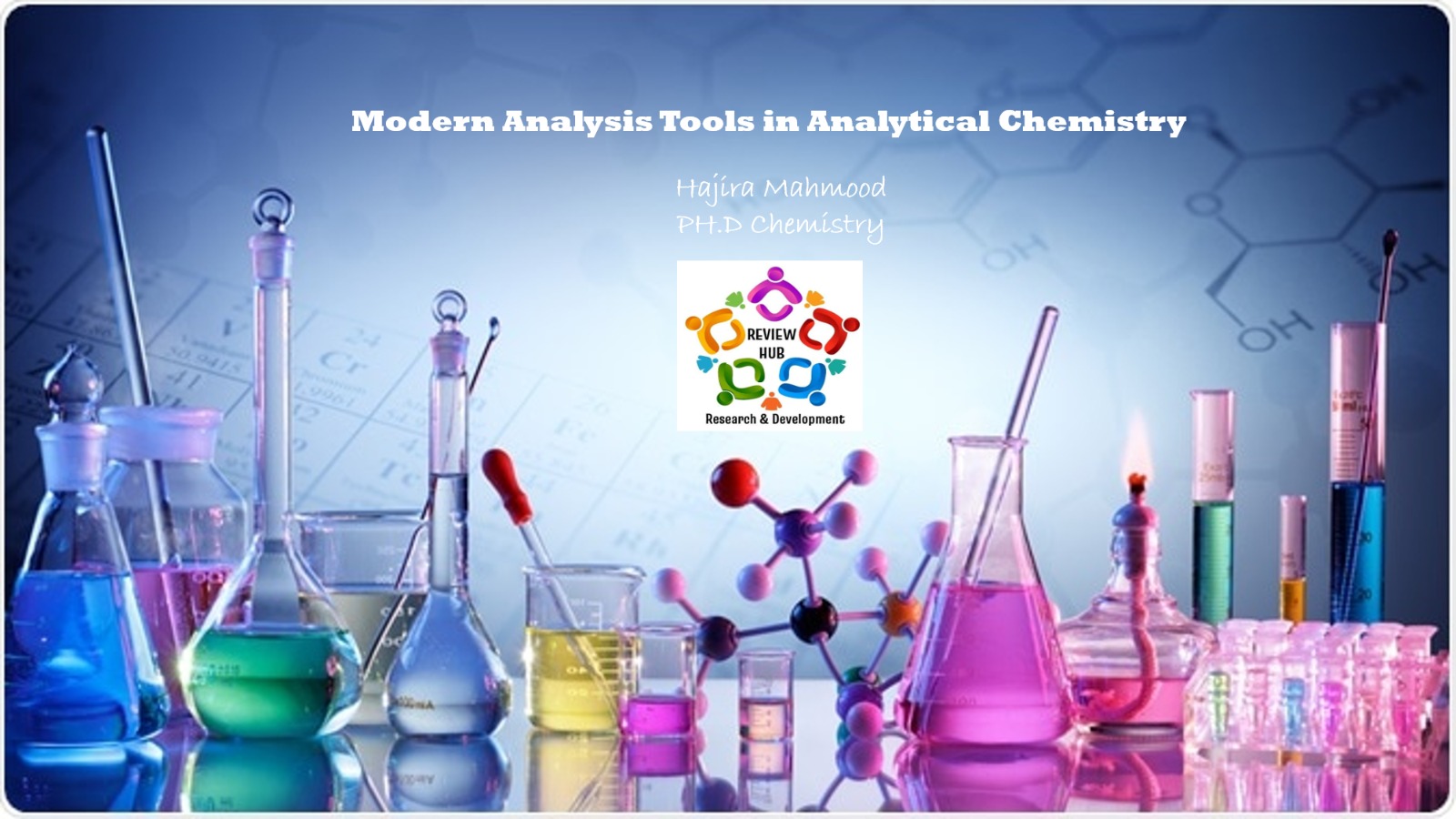Modern Analysis Tools in Analytical Chemistry. Modern analytical chemistry is constantly evolving with advancements that stretch the limits of detection, accuracy, and speed. As the complexity of analytical challenges increases, state-of-the-art tools are essential for scientists to explore, quantify, and understand the myriad substances that they encounter in their research be they novel pharmaceuticals, environmental samples, or the frontiers of materials science.
Author: Hajira Mahmood
LinkedIn: Click here to see Hajira’s profile
Today’s analytical chemist is equipped with an arsenal of sophisticated instruments and methodologies that enable precise qualitative and quantitative assessments. These tools span a wide range of techniques, each with its unique strengths and applications. Unraveling the potential and functionality of these techniques is key to pushing the boundaries of what can be measured and known.
Spectroscopy Techniques: UV-Vis, IR, NMR, Mass Spectrometry
Each spectroscopy technique in analytical chemistry unveils different facets of molecular identity and structure. Ultraviolet-visible (UV-Vis) spectroscopy provides valuable insights into the electronic structure of molecules, closely tied to their absorbance characteristics. Meanwhile, infrared (IR) spectroscopy is a powerhouse for identifying functional groups within compounds, tracing vibrations of molecular bonds.
Nuclear Magnetic Resonance (NMR) spectroscopy takes it a step further by offering detailed molecular topographies, allowing chemists to traverse the complex landscape of molecular architecture. Lastly, mass spectrometry (MS) stands out as a detective, identifying molecules by their mass-to-charge ratio with an unparalleled level of finesse, even capable of elucidating molecular weights and compositions of entirely unknown substances.
UV-Vis Spectroscopy
Primarily used for studying the absorbance of light and its interaction with matter. Key for understanding the electronic transitions in molecules.

Infrared (IR) Spectroscopy
IR identifies molecular vibrations, providing a fingerprint for functional groups within complex structures, essential in organic and inorganic chemistry.

NMR & Mass Spectrometry
NMR reveals molecular frameworks with high precision, while mass spectrometry allows the identification and structural elucidation of components in a mixture.

Chromatography Techniques: HPLC, GC, TLC
The application diversity within chromatography is immense. High-Performance Liquid Chromatography (HPLC) is a vital workhorse in pharmaceuticals due to its unmatched capability in separating complex mixtures. Gas Chromatography (GC) aptly separates volatile compounds, frequently deployed when analyzing environmental pollutants or forensic substances.
Thin Layer Chromatography (TLC) offers a quick and straightforward means of separating components, valuable for on-the-spot analysis or as a preparatory step for more refined techniques. These methods give chemists the power to peek into a compound’s intricate composition, unraveling the hidden layers of chemical interactions and purities.
High-Performance Liquid Chromatography (HPLC)
Essential for resolving complex biological and synthetic mixtures; optimized for speed, resolution, and quantification.

Gas Chromatography (GC)
Best suited for volatile substances; extensively employed in toxicology, environmental analysis, and quality control.

Thin Layer Chromatography (TLC)
An accessible, screening tool that’s instrumental in educational settings and as a preliminary analysis method in research.

Electrochemical Techniques: Voltammetry, Potentiometry
Voltammetry and potentiometry form the bedrock of electrochemical analysis, each exploring the redox behavior of substances through different lenses. Voltammetry records current as potential varies, unmasking the dynamic redox processes. By alternatively holding the voltage constant, potentiometry measures the potential, providing a direct gauge of species concentration.
Employed in settings ranging from environmental sensing to the research of electroactive compounds, these techniques are crucial for their sensitivity and selectivity in detecting trace elements and molecules.
Voltammetry
Explores electron transfer kinetics in redox. Often used in the examination of medical sensors and battery technologies.

Potentiometry
Great for measuring ion concentrations. Commonly involved in pH sensing and the food industry for quality control.

Thermal Analysis Techniques: DSC, TGA, TMA
Thermal analysis unveils material properties under the influence of temperature changes. Differential Scanning Calorimetry (DSC) is profoundly insightful for studying phase transitions and estimating thermal stability, making it indispensable in polymer science and pharmaceuticals. Thermogravimetric Analysis (TGA) tracks weight changes to decipher decomposition patterns, pivotal for compositional analysis.
Thermomechanical Analysis (TMA) measures the dimensional response of materials, crucial for understanding expansion properties and mechanical behaviors. Each of these techniques guides materials scientists, chemists, and engineers in constructing heat profiles essential for material design and evaluation.
Differential Scanning Calorimetry

Thermogravimetric Analysis
Monitors change in material weight under controlled temperature, an excellent tool for the study of thermal stability and composition.

Thermomechanical Analysis
Measures physical changes in dimensions, offering insights into mechanical properties related to temperature variations.

Microscopy Techniques: SEM, TEM, AFM
Scanning Electron Microscopy (SEM), Transmission Electron Microscopy (TEM), and Atomic Force Microscopy (AFM) serve as gateways to the nanoworld. SEM paints a detailed landscape of surface topography, while TEM penetrates deeper, imaging the innermost structure of sample material. AFM, on the other hand, stands unique by feeling the surface at the atomic level, making visible the invisible forces that define molecular interactions and surface properties.
Transcending mere magnification, these microscopy methods are indispensable tools for material scientists, biologists, and nanotechnologists in their quest to visualize and understand substances at the most intricate level.
Scanning Electron Microscopy (SEM)
Provides topographical contrast and material composition at nanoscale resolution, exemplifying surface analysis.

Transmission Electron Microscopy (TEM)
Gives access to the inner structure of materials at the atomic level, essential for detailed structural analysis.

Atomic Force Microscopy (AFM)
Enables the mapping of surfaces down to the atomic scale by detecting interatomic forces, vital for molecular and materials research.

Data Analysis and Interpretation Methods
In analytical chemistry, the deluge of data from various sophisticated instruments necessitates robust analysis and interpretation methods. Whether it’s multivariate statistics in spectroscopy, chemometrics in chromatography, or image analysis in microscopy, these methods transform raw data into meaningful insights.
Machines and algorithms are engaged to discern patterns, correlate structures with properties, and predict behaviors, turning vast datasets into actionable knowledge. This section of analytical chemistry is as much about creativity and critical thinking as it is about numbers and figures.
Statistical Models
Critical for discerning significance in data, statistical models underpin hypothesis testing and experimental validation.
Chemometrics
Utilizes mathematical and statistical techniques to extract valuable information from chemical data, enhancing instrument performance.
Converts microscopic images into quantitative data, allowing for in-depth characterization and measurement at micro and nano scales.
Conclusion and Future Prospects
The panorama of analytical chemistry is driven by relentless innovation and cross-disciplinary integration. With enhanced precision, chemists are forging a pathway to breakthroughs in medicine, environmental protection, and material development. The future beckons with tantalizing prospects such as real-time diagnostics, nano-scale synthesis, and the artificial intelligence-led analysis that will deepen our grasp of the chemical foundations of the world.
As we continue to advance, the central role of analysis tools in chemistry becomes ever more apparent, not just in expanding our understanding but in enabling solutions to global challenges. The edifice of analytical chemistry stands robust, ready to meet the unknown with sharp instruments and sharper minds.
| UV-Vis and IR Spectroscopy | Expanding role in environmental monitoring |
| Mass Spectrometry | Advancements in speed and sensitivity |
| Chromatography | Developments towards microfluidics and on-chip technologies |
| Microscopy | Progressing towards higher resolution and real-time analysis |
| Data Science | Fusion of AI and big data in predictive modeling |
Also read: Reticular Chemistry: A Story of Tiny Components and Endless Opportunities
Follow Us on

